Re: Army Air Forces and Other World War II Forms
Sun May 17, 2020 4:34 pm
gemmer wrote:Here's one from the Swoose. Page one is on the bottom.
Sorry, I forgot to say thanks in my last post.
Unfortunately, Googling for these forms has become more difficult because I have exhausted all the easy to find results and searching for "AAF Form No." now ends up just tracking back to this thread or sources already referenced in it. There are essentially two types of entries in this thread: forms I have found titles for, but no images and forms I have found images for. If I can find at least the title of the form, it makes finding an image significantly easier because I then have a unique set of words to search for.
I got lucky today and came across a book with a bunch of Air Corps forms. Although some of the layouts are different, it seems that the these forms were carried over into the Army Air Force, as the numbers match with the latter. This should hopefully fill in the some of blanks on the list of titles. Also note that there are two forms (IGD Form No. 1 and AGO Form No. 15) that I chose not to include even though they were listed because they are not technically AC/AAF Forms. Finally, forms 9, 41, 41A, and 41B are mentioned, but samples are not included.
AAF Form No. 1, 1A - Flight Report (Operations), Flight Report (Engineering)
(Source: Google Books)
AAF Form No. 1, 1A - Flight Report (Operations), Flight Report (Engineering) [Supplement]
(Source: Google Books)
AC Form No. 15 - Invoice
(Source: Google Books)
AC Form No. 17 - Damage to Property Certificate
(Source: Google Books)
AC Form No. 23 - Aircraft Clearance [Alternate Version]
(Source: Google Books)
AC Form No. 46 - Parachute Record
(Source: Google Books)
AC Form No. 48 - Work Order
(Source: Google Books)
AC Form No. 49, 50, 51, 83 - Serviceable Part Tag, Repairable Part Routing Tag, Condemned Part Tag, Identification Tag
(Source: Google Books)
AC Form No. 54 - Unsatisfactory Report
(Source: Google Books)
AC Form No. 55 - Technical Order Compliance Report (Duplicate)
(Source: Google Books)
AC Form No. 58 - Parachute Inspection and Drop-Test Card
(Source: Google Books)
AC Form No. 60A - Technical Instruction Compliance Record (Aircraft) [Alternate Format]
(Source: Google Books)
AC Form No. 61 - Propeller Historical Record
(Source: Google Books)
AC Form No. 81 - Stores Charge
(Source: Google Books)
AC Form No. 82 - Stores Credit
(Source: Google Books)
AC Form No. 99 - Memorandum Receipt
(Source: Google Books)
AC Form No. 241 - Instruction Slip
(Source: Google Books)
AC Form No. 243 - Bill of Material
(Source: Google Books)
AC Form No. 249 - Stores Exchange
(Source: Google Books)
AAF Form No. 24 - Pilot's Information File (Table of Contents)
(Source: Google Books)
AAF Form No. 35 - Radio Log
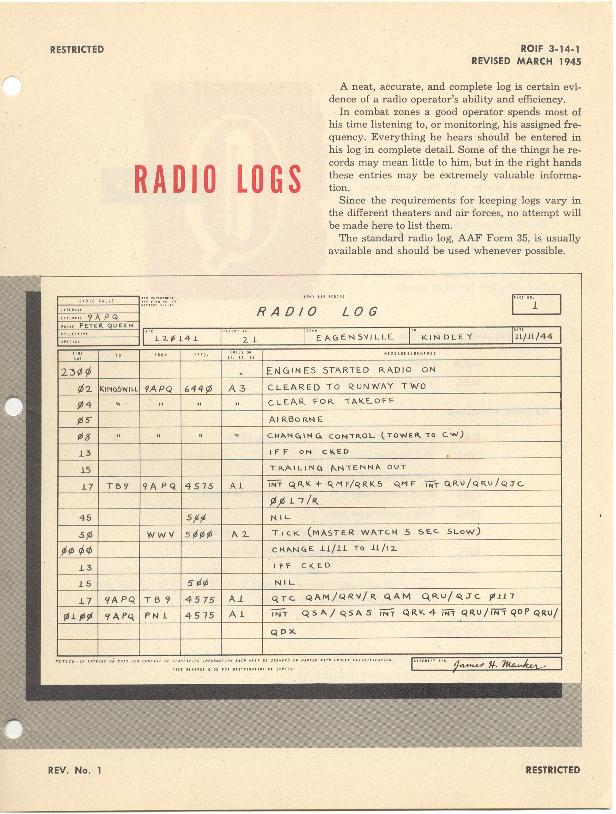
(Source: Angelfire)
Jim MacDonald wrote:I wish there was something like that available for WWII Naval Aviation forms.
I tried doing a bit more looking on this subject and, to the best I can determine, most of the forms are identified with the abbreviation "NavAer" followed by a three or four digit number. However, there are two other formats apparently in use. One is the letters "DD" followed by a three digit number and sometimes a another letter. The other is the abbreviation "OPNAV" followed by a four digit number, a hyphen, and another one or two digit number. (These may be related to a 1959 "Navy-Marine Corps Standard Subject Classification System", but the subjects and numbers don't seem to match up. A 1958 guide seems to suggest that "Aeronautical Material" had its own separate subject group and format.) Note that while I based all of the above on a 1954 Aviation Machinist Mates' Manual, at least the "NavAer" and "OPNAV" were in use during World War II. Also, according to the aforementioned manual, what you want to look up is the Naval Aeronautic Publications Index, NavAer 00-500. I was able to find a partial list of forms from a 1945 edition of the United States Navy Regulations:
List of NavAer Forms
- NavAer 333A - Aircraft Engines Report
- NavAer 337 - Aircraft Recommended for Striking
- NavAer 338 - Weekly Aircraft Receipt and Transfer Report
- NavAer 339 - Aircraft Trouble Report
- NavAer 421 - Quarterly Pilot Flying Report
- NavAer 422 - Property Damage Report
- NavAer 432 - Monthly Aircraft Flying Report
- NavAer 443A - Monthly Aerological Report (Standard Observations)
- NavAer 443B - Monthly Aerological Report (Hourly Observations and Journal)
- NavAer 443C - Monthly Aerological Report (Upper Air)
- NavAer 443D - Monthly Aerological Report (Surface Winds and General Summary)
- NavAer 446A - Aerological Inventory (Supplies)
- NavAer 446B - Aerological Inventory (Instruments)
- NavAer 4112 - Report of Unsatisfactory or Defective Material
- NavAer 4113 - Report of Ferrying Flight (Made by Ferry Pilot)
Reference: United States Navy Regulations (727)
Lastly, if you're as interested in organization as I am - or question the utility of good record keeping - I highly encourage you to check out the American Aviation Historical Society's article about Sarah Clark's work managing the files at Wright Field.
EDIT: A few more additions:
List of AAF Forms (Cont.)
- AAF Form No. 242 - Foreman's Progress Report[1]
- AAF Form No. 243 - Bill of Material[1]
- AAF Form No. 250 - Time Card[1]
AAF Form No. 12C - Bombing Flight Record
[PDF File]
(Source: Army Air Forces Collection)
AAF Form No. 58 - Parachute Inspection and Drop-Test Card

(Source: The Memory Project)
Also, Air Corps and Army Air Force Form No. 55 and 99 are apparently different.
EDIT 2: Some Air Corps forms from 1924:
List of AC Forms
- AC Form No. 136 - Training and Operations Reports[2]
- AC Form No. 160 - Unsatisfactory Performance Report[2]
- AC Form No. 192 - Consolidated Aircraft and Engine Report[2]
- AC Form No. 193 - Consolidated Operations and Status of Equipment Report[2]
- AC Form No. 201 - Station Parachute Record[2]
- AC Form No. 227 - Pilot Book[2]
Re: Army Air Forces and Other World War II Forms
Mon May 18, 2020 8:19 pm
I started looking into Air Corps forms, and found a few more:
List of AC Forms (Cont.)
List of AAF Forms (Cont.)
List of Unknown Forms
AC Form 41-B - Maintenance Inspection Record




(Source: WorthPoint)
AAF Form No. 54 - Unsatisfactory Report

(Source: Hathi Trust)
The full "ACA 551 (CPT 41) - Student Pilot Rating Book" can also be found on Hathi Trust. (I am not going to reproduce all 150+ pages here.)
Finally, here's a few other forms with no known number, but may be from the above sequences:
Forced Landings of Engineering Division Airplanes
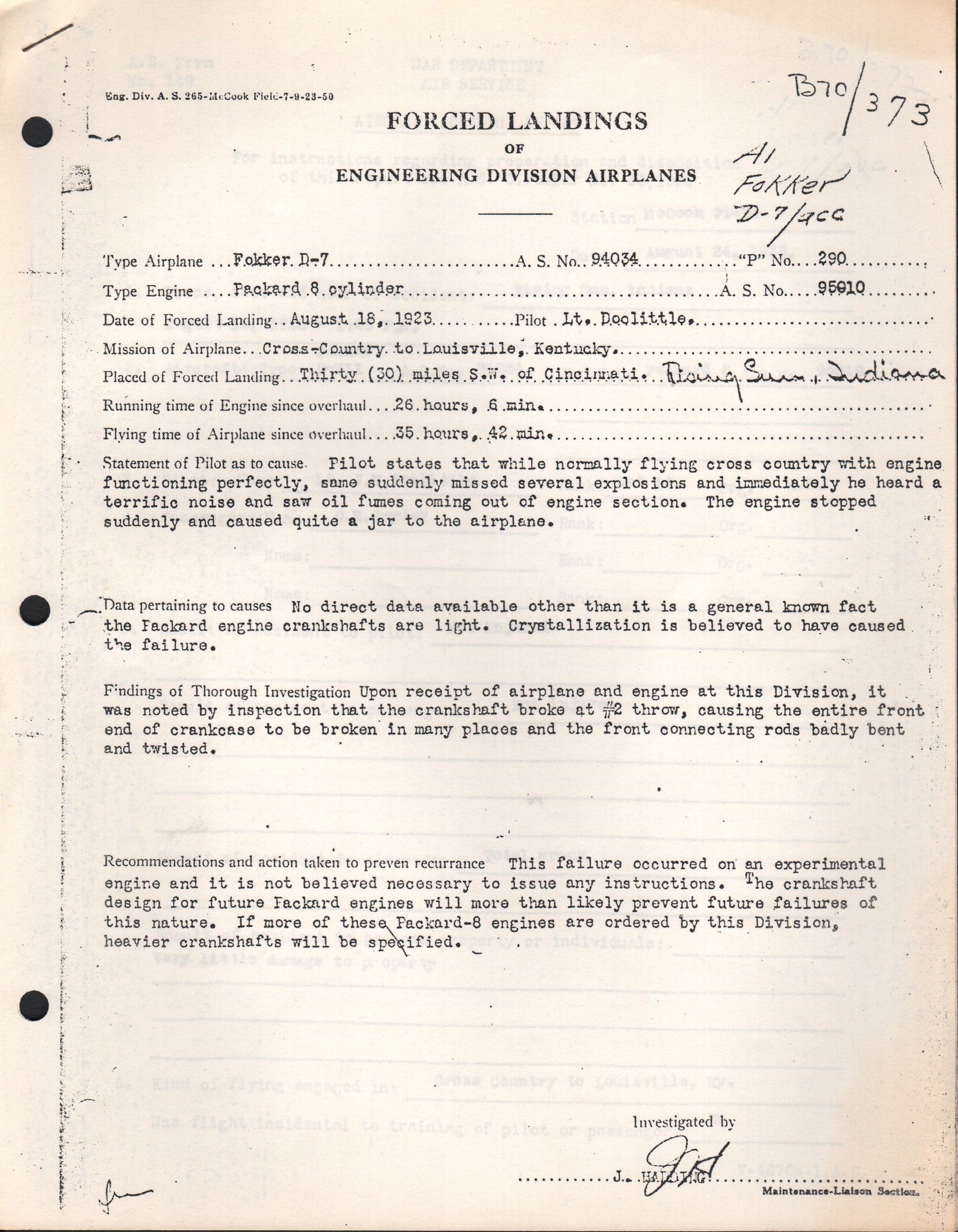
(Source: Early Aeronautica)
Official Airplane Report






(Source: Hathi Trust)
EDIT: A few additions:
List of AC Forms (Cont.)
The numbers for the following have been assumed based on the observed trend that many forms share their number with the circular about them:
List of AC Forms (Likely Numbers)
List of AC Forms (Cont.)
- AC Form No. 1 - Forced Landing Report[1]
- AC Form No. 3 - Monthly Aircraft Operations Report[2]
- AC Form No. 4 - Training and Operations[2]
- AC Form No. 11 - Transcript of Flying Record[1]
- AC Form No. 14 - Aircraft Accident Report[1]
- AC Form No. 15 - Fuel and Lubricants for Government-Owned Aircraft[3]
- AC Form No. 24 - Flight Performance Record[4]
- AC Form No. 41 - Airplane Maintenance Inspection Record[2]
- AC Form No. 43 - Armament Inspection Record[5]
- AC Form No. 84 - Bin Card[2]
- AC Form No. 95 - Monthly Aircraft Report[2]
List of AAF Forms (Cont.)
- AAF Form No. 36 - Weather Station Operations Report[6]
- AAF Form No. 108W - Weather Station Equipment Report[6]
- AAF Form No. 203 - Care of Flyer Report[7]
List of Unknown Forms
- Form No. 219 - Airplane Flight Report[8]
AC Form 41-B - Maintenance Inspection Record




(Source: WorthPoint)
AAF Form No. 54 - Unsatisfactory Report
(Source: Hathi Trust)
The full "ACA 551 (CPT 41) - Student Pilot Rating Book" can also be found on Hathi Trust. (I am not going to reproduce all 150+ pages here.)
Finally, here's a few other forms with no known number, but may be from the above sequences:
Forced Landings of Engineering Division Airplanes

(Source: Early Aeronautica)
Official Airplane Report
(Source: Hathi Trust)
EDIT: A few additions:
List of AC Forms (Cont.)
- AC Form No. 245 - Summary of Direct Labor Charges to Accounts[9]
The numbers for the following have been assumed based on the observed trend that many forms share their number with the circular about them:
List of AC Forms (Likely Numbers)
- AC Form No. 59A - Technical Report of the Aircraft Accident Classification Committee [May have become No. 14A][2]
- AC Form No. 69A - Monthly Activity Report [May have become No. 32A][2]
Last edited by Noha307 on Mon Jul 20, 2020 5:30 pm, edited 1 time in total.
Re: Army Air Forces and Other World War II Forms
Wed May 20, 2020 6:05 pm
List of AAF Forms (Cont.)
Note that while some of these forms below have been included earlier in this thread, the copies below are higher quality or the image can be linked directly into the thread:
AAF Form No. 8 - Instrument Pilot Certificate (White)

(Source: Internet Archive)
AAF Form No. 8B - Pilot Instrument Certificate Application and Flight Check Form


(Source: Internet Archive)
AAF Form No. 28-A - Physical Fitness Test and Record Card[,] Cumulative Record


(Source: Internet Archive)
AAF Form No. 28-B - Physical Fitness Test and Record Card[,] Cumulative Record

(Source: Internet Archive)
AAF Form No. 34 - Weekly Status and Operations Report
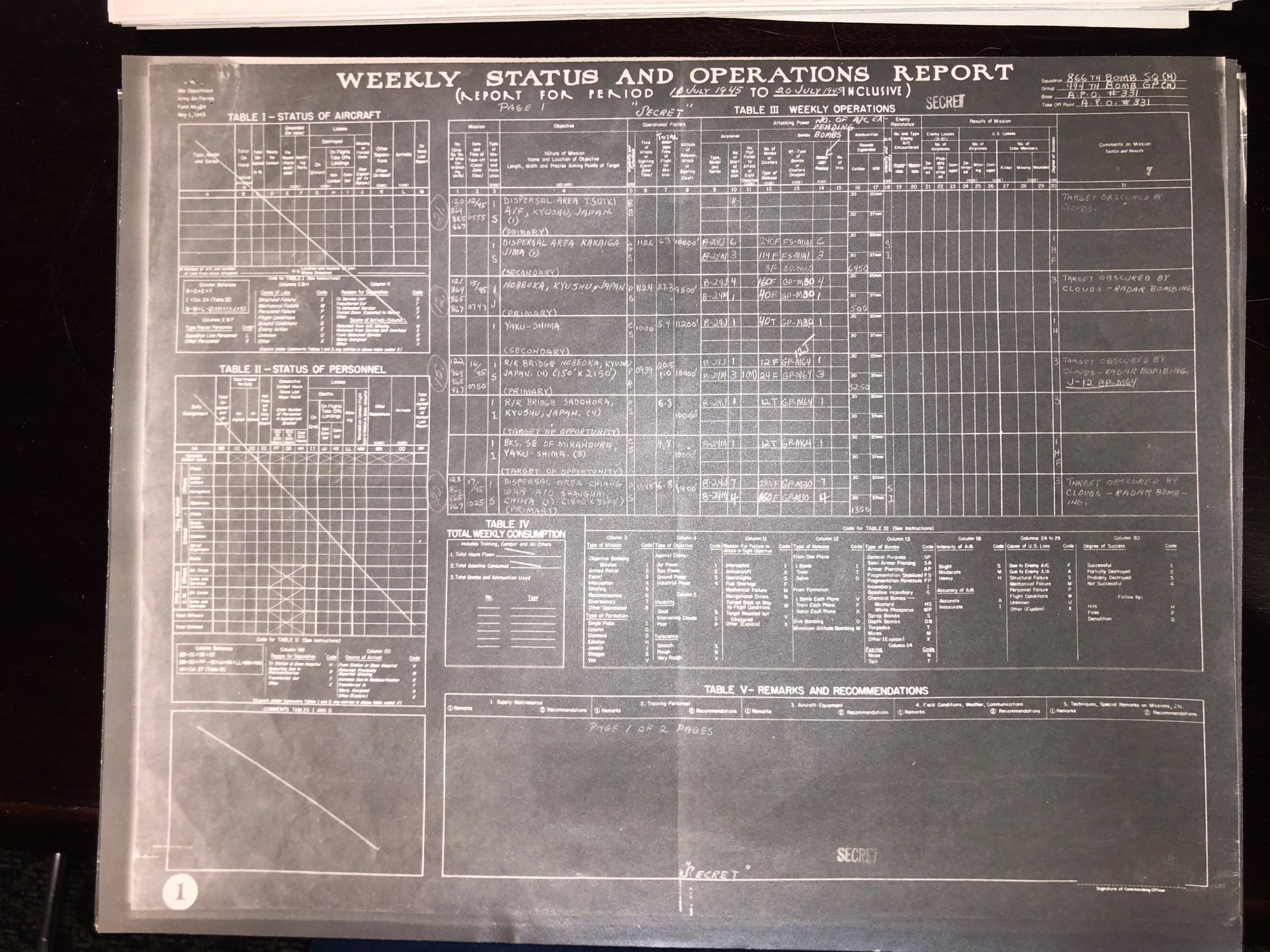
(Source: American POWs in WWII Hiroshima)
In the process of writing this post, I also found a thread from 2008 about someone asking for a copy of a Form No. 34. Unfortunately, I don't think this image would help, since it is not high enough resolution to read most of the text.
AAF Form No. 63 - Foreign Airport Description
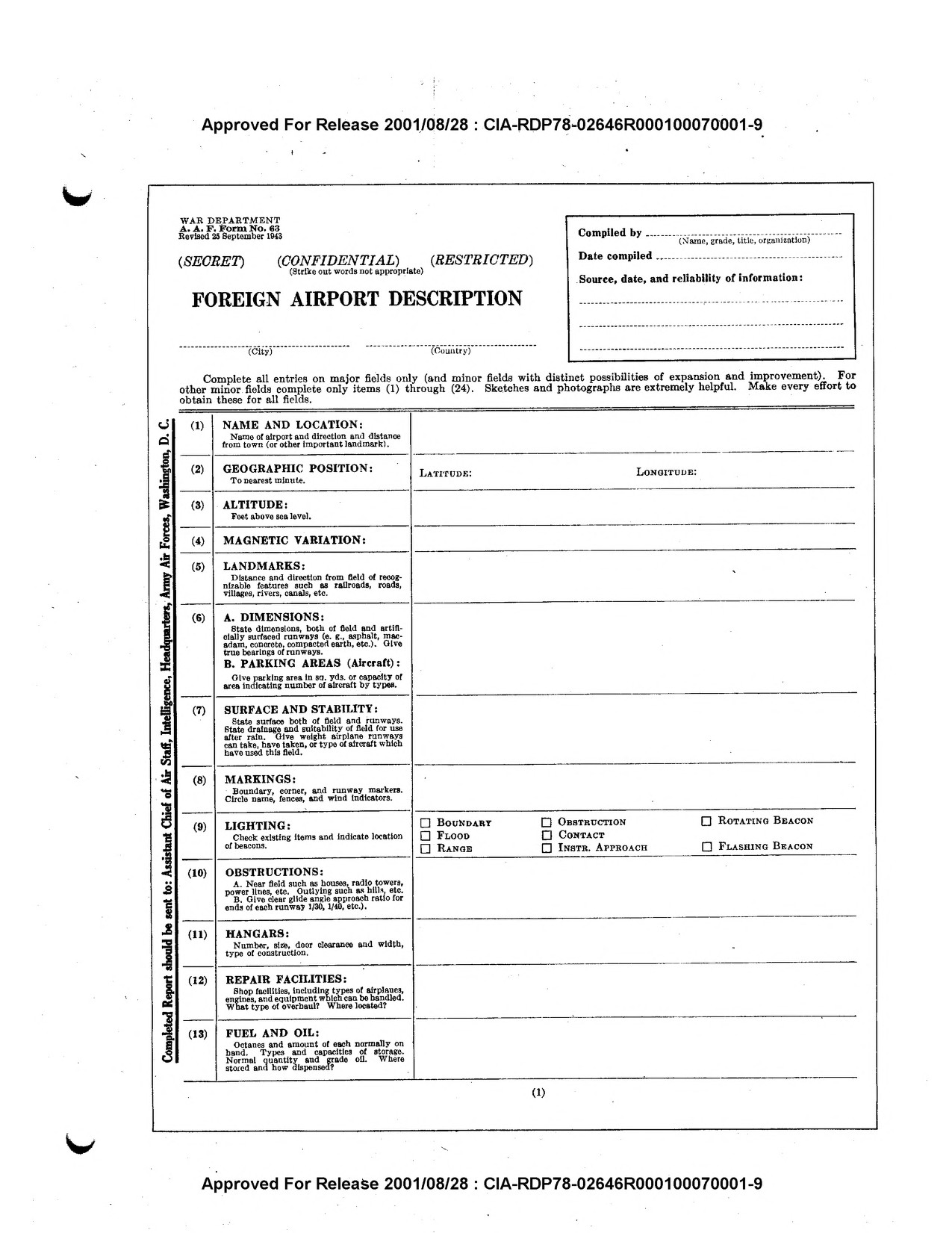
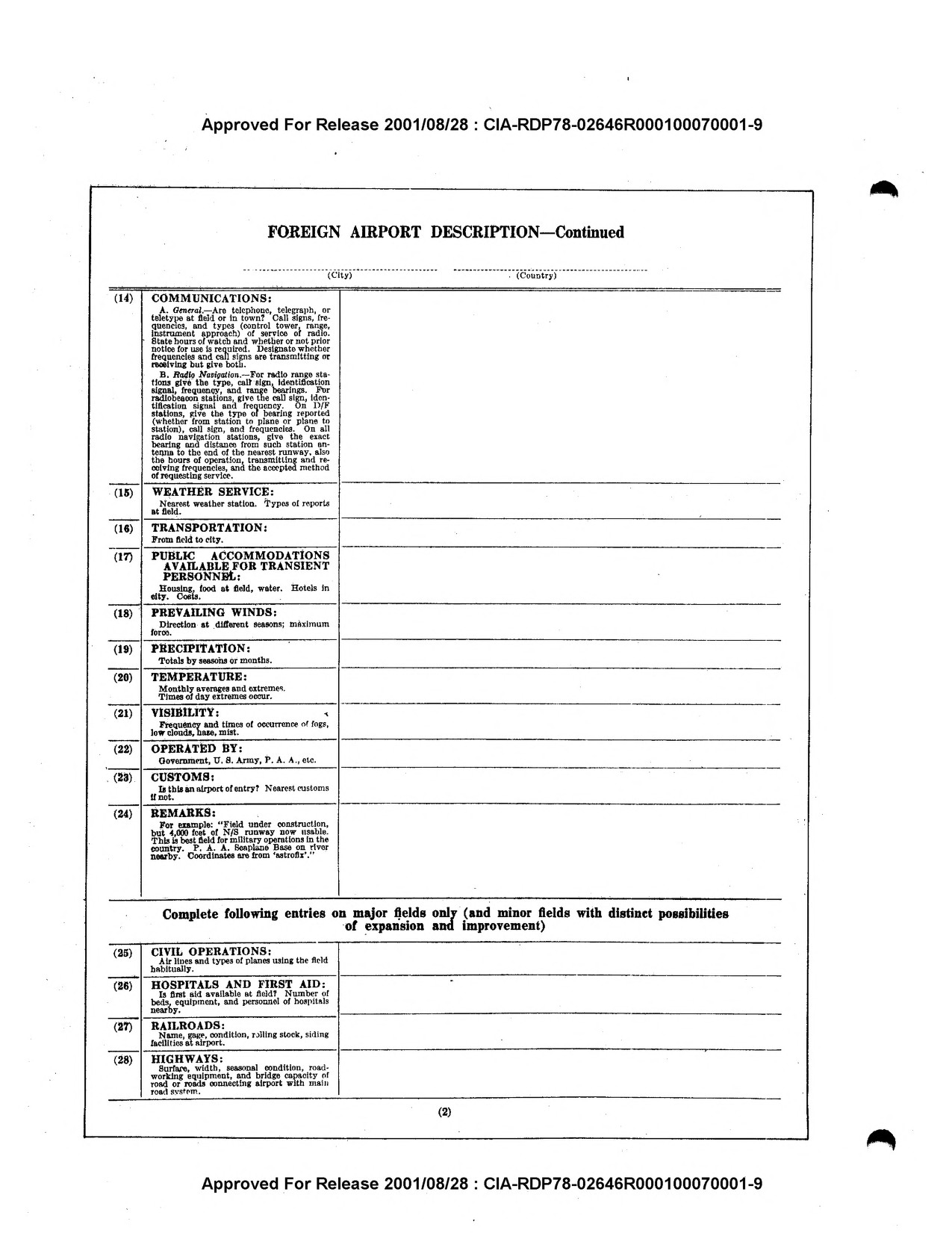
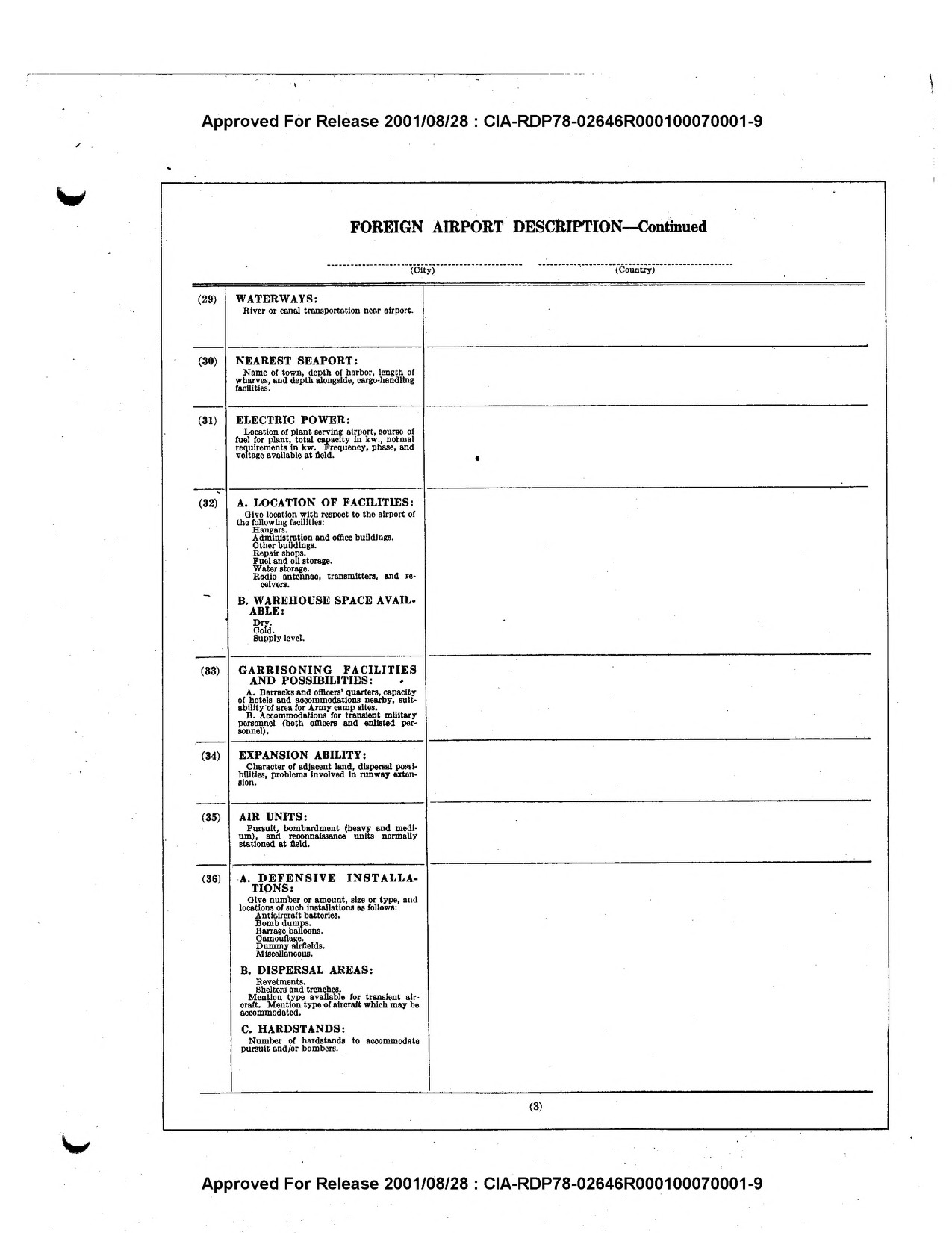
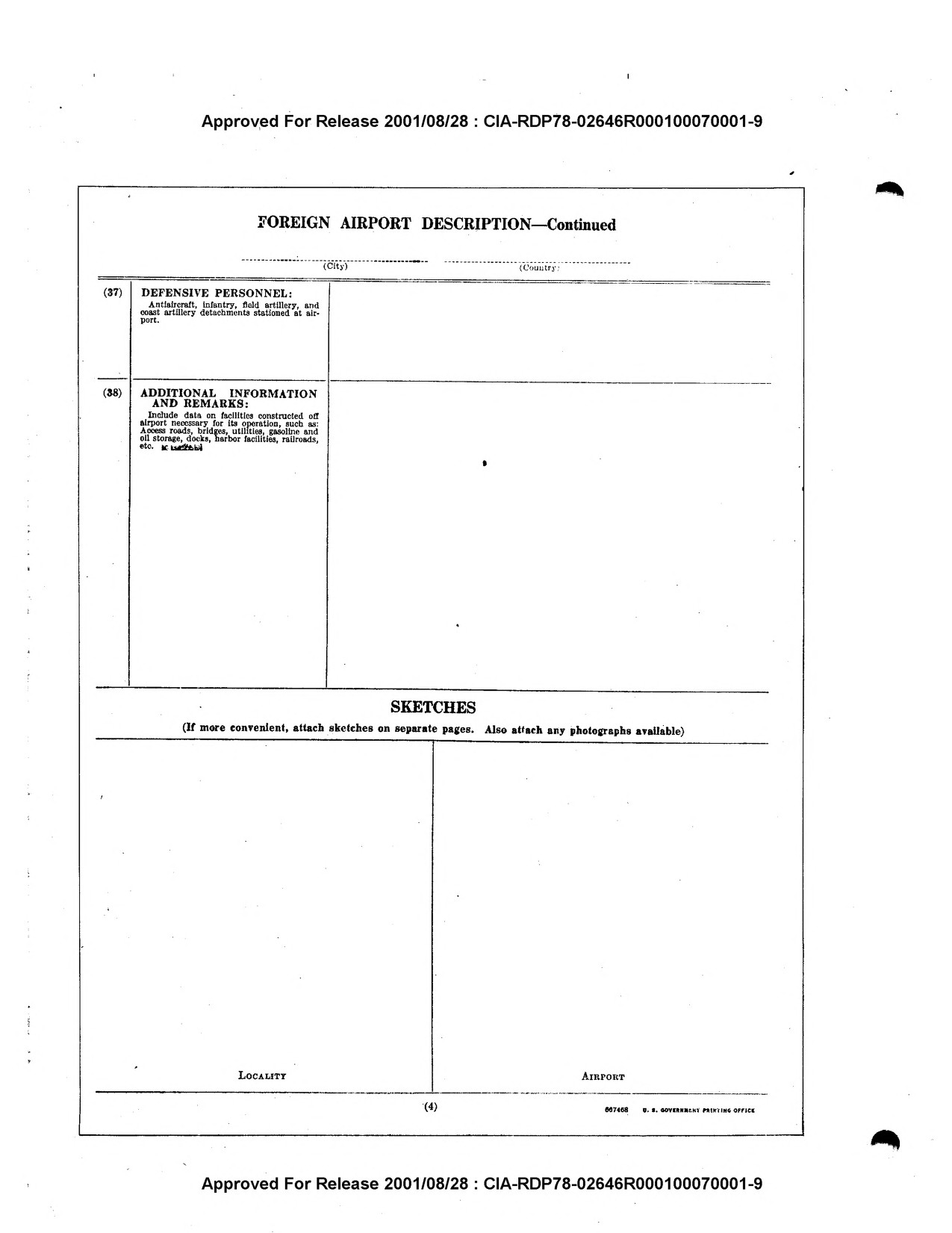
(Source: Internet Archive)
The single apparent difference between this version (1946) and the 1944 one is that the former has check boxes in the "lighting" section.
As in the previous post, here's another form with no known number, but may be from the above sequences:
Army Air Forces Medical Statement for Officers


(Source: Internet Archive)
Also, USAAF Historical Study No. 51 contains a description of the evolution of forms no. 1 and 41:
(Source: Internet Archive)
Finally, the Air Force Historical Research Agency has a microfilmed lecture about the use of form no. 1 and 1A. They also have a different microfilmed document simply titled "Aircraft Maintenance Forms (Form No. 1)".
- AAF Form No. 21E - Airspeed Calibration Card[1]
- AAF Form No. 21M - Altimeter Scale Correction Card[1]
Note that while some of these forms below have been included earlier in this thread, the copies below are higher quality or the image can be linked directly into the thread:
AAF Form No. 8 - Instrument Pilot Certificate (White)
(Source: Internet Archive)
AAF Form No. 8B - Pilot Instrument Certificate Application and Flight Check Form
(Source: Internet Archive)
AAF Form No. 28-A - Physical Fitness Test and Record Card[,] Cumulative Record
(Source: Internet Archive)
AAF Form No. 28-B - Physical Fitness Test and Record Card[,] Cumulative Record
(Source: Internet Archive)
AAF Form No. 34 - Weekly Status and Operations Report

(Source: American POWs in WWII Hiroshima)
In the process of writing this post, I also found a thread from 2008 about someone asking for a copy of a Form No. 34. Unfortunately, I don't think this image would help, since it is not high enough resolution to read most of the text.
AAF Form No. 63 - Foreign Airport Description
(Source: Internet Archive)
The single apparent difference between this version (1946) and the 1944 one is that the former has check boxes in the "lighting" section.
As in the previous post, here's another form with no known number, but may be from the above sequences:
Army Air Forces Medical Statement for Officers
(Source: Internet Archive)
Also, USAAF Historical Study No. 51 contains a description of the evolution of forms no. 1 and 41:
Capt. Robert W. Ackerman wrote:Originally issued as a large, single sheet which was affixed to a board, it later appeared as a pamphlet (Form No. 41B). Also, it was simplified when special inspection check lists were developed for each model of airplane. During 1944, a new form combining Forms No. 1 and 41B was devised for service test, but final adoption was delayed pending the end of the war.
(Source: Internet Archive)
Finally, the Air Force Historical Research Agency has a microfilmed lecture about the use of form no. 1 and 1A. They also have a different microfilmed document simply titled "Aircraft Maintenance Forms (Form No. 1)".
Last edited by Noha307 on Tue Jul 14, 2020 8:51 pm, edited 1 time in total.
Re: Army Air Forces and Other World War II Forms
Sun May 24, 2020 5:32 pm
List of AAF Forms (Cont.)
AAF Form No. 18A - Monthly Runway Traffic Report of Airplane Landings and Take-Offs

(Source: Google Books)
AAF Form No. 57 - Compass Correction Card

(Source: Hathi Trust)
There's also a single reference that suggests that AAF Form No. 64 may be related to an examination in some way.[2]
AAF Form No. 1 is shown being filled out in a picture - the caption of which describes it as something that "every pilot knows":
(Source: “[Untitled],” San Fernando Valley Times, March 26, 1945, n.p.)
Many of the forms were managed by the Statistical Control Section of a unit. As described in a 1945 article:
(Source: “Statistical Control Section,” Nevada State Journal, September 22, 1945, n.p.)
Finally, the introduction to the Personnel, Training and Crews section in the December 1945 Army Air Forces Statistical Digest provides a more detailed description of the development and usage of AAF Form No. 127 and its importance to statistical analysis:
(Source: Internet Archive)
It is worth noting that, similar to forms 125 and 126 as mentioned in a previous post, form 127 was also newly created during the war.
Similarly, the introduction to the Operations section states:
(Source: Internet Archive)
Again, note that the third paragraph of the above describes Aircraft Record Cards, or something very similar to them.
Lastly, is the introduction to the Operations section:
(Source: Internet Archive)
- AAF Form No. 127 - Personnel Report[1]
AAF Form No. 18A - Monthly Runway Traffic Report of Airplane Landings and Take-Offs
(Source: Google Books)
AAF Form No. 57 - Compass Correction Card
(Source: Hathi Trust)
There's also a single reference that suggests that AAF Form No. 64 may be related to an examination in some way.[2]
AAF Form No. 1 is shown being filled out in a picture - the caption of which describes it as something that "every pilot knows":
(Source: “[Untitled],” San Fernando Valley Times, March 26, 1945, n.p.)
Many of the forms were managed by the Statistical Control Section of a unit. As described in a 1945 article:
Personnel Service Office wrote:The most important mission of Statistical Control is the gathering of information from all sections of the base to be evaluated and presented in chart form to the commanding officer and his staff to assist them in the effective planning of current and future operations. This responsibility is met by the assignment of an experienced draftsman to this section by whom charts are prepared, information is evaluated, entered on the charts, and then kept in the Air Room to be referred to by the CO and staff. Statistical control is also charged with the consolidating and auditing for accuracy of all squadron morning reports and the preparation of AAF Form 127 (Military Personnel Report). Operations statistics, also depicted on this cover, is charged with the responsibility of preparing and submitting reports dealing with the activity of all the aircraft at this base. An invitation is extended to all military personnel to visit the Air Room at which time an explanation of the charts will be made, thereby passing information to you that might assist in the part you play in the accomplishment of the mission of this base.
(Source: “Statistical Control Section,” Nevada State Journal, September 22, 1945, n.p.)
Finally, the introduction to the Personnel, Training and Crews section in the December 1945 Army Air Forces Statistical Digest provides a more detailed description of the development and usage of AAF Form No. 127 and its importance to statistical analysis:
Office of Statistical Control wrote:Because the waging of air warfare requires a complex combination of man and machines, It was apparent early in World War II that existing Army personnel reports were entirely Inadequate for intelligent training, placement and control of Army Air Forces personnel. Reports were found to be necessary which contained vastly more detailed information, both qualitative and quantitative.
This requirement resulted in the Institution of two entirely new concepts in personnel reporting; first, the reporting of all personnel by military specialty (that is, by the job held and by qualification to hold a particular Job), and second, the skeletal reporting of trained combat personnel as the unit in which they fight (that is, crew reporting). Both of these new concepts were inaugurated in a new type of personnel report, known throughout the Air Forces as the AAF Form 127 report.
Despite the complexity of this report, its comprehensive coverage of all pertinent personnel information immediately simplified the entire field of personnel management within the AAF. For, by preparing sufficient copies of the 127 report at each base or administrative unit, the Air Forces permitted each echelon of command, up to and including Headquarters, Army Air Forces, simultaneously to have available identical personnel Information for each AAF base and unit.
Furthermore, this report was specifically designed so that it might be used at the lower operating echelons for the transfer, placement and reassignment of specific personnel while at the same time it could be used at the higher planning echelons in the formulation of policy decisions controlling the overall flow and training of AAF personnel.
So successful was the initial concept of this report, that, despite frequent changes in types of detailed personnel information required during the progress of the war, the basic framework of the 127 report was never altered. Early in 1943 the combat crew section was required at a greater frequency than the balance of the personnel information of the 127, and accordingly it was set up as a separate report.
The largest and most valuable section of the 127 report was that devoted to tbs reporting of AAF personnel by military occupational specialty, and thus, several pages of the personnel section of this book are devoted to summary information on specialty data. The 127 report has also served as the source of the basic data from which the summaries have been prepared on strength data by location, grade, arm and service, sex, race and function (Continental US only). Furthermore, the data on shipments of AAF personnel to and from overseas theaters have been compiled from individual 127 reports. All casualty data have been obtained through The Adjutant General's Office. Civilian personnel data have been derived from a companion report to the 127, known as the AAF Form 134 report.
Because the 127 report is an Inventory report showing status as of a particular date, it was never possible to incorporate so-called flow and progress information of tbs type required for complicated training scheduling. Thus, within the general framework of the 127 report, several detailed training reports were instituted for the Training Command. The training statistics included in the following pages are generally derived from these special reports.
AAF personnel statistics have--as a result of the world-wide 127 report--provided a unique opportunity to all higher headquarters throughout the Air Forces for the preparation of meaningful studies and analyses which in turn have provided a constant stimulus to action on the part of staff officers. Chief virtue of the 127 report for this purpose has been that it always provided exactly comparable data for every single unit and person in the entire Army Air Forces--and this data have been collected on a comparable basis from the inception of the report until the end of the war. For example, considerable time has bean spent in studying the utilization of so-called maintenance personnel in relation to the workload imposed; the results of these studies have been apparent in the "improved maintenance” in various units or commands which were found to be lagging. Another profitable type of personnel study has been the projection of personnel requirements by specialty against the projected availability. By anticipating casualties and other attrition, by calculating future increases or decreases in requirements and by taking into account the length of the training pipeline, it has been possible throughout the war to control the input of personnel into the various courses of instruction so that the AAF did not suffer any severe portages of critically needed specialists.
(Source: Internet Archive)
It is worth noting that, similar to forms 125 and 126 as mentioned in a previous post, form 127 was also newly created during the war.
Similarly, the introduction to the Operations section states:
Office of Statistical Control wrote:When the Army Air Forces began its unprecedented expansion from peace-time to war-time strength, two problems of materiel management became most critical: the determination of advance requirements and the effective distribution of equipment on hand. Requirements for aircraft, for spare parts and for expendable supplies had to be gauged for long periods ahead because the production cycle was as long as two years for some items. It was also necessary to make new calculations of the useful life and required replacement rates of aircraft and equipment under combat conditions abroad and under intensified training operations in the United States. In order to study requirements and to make the necessary forward estimates, it was mandatory that a reporting system be developed to provide current, continuous data on aircraft and equipment on hand and on inventory gains and losses.
The problem of effective distribution of equipment on hand could be solved only through a similar reporting system. The Army Air Forces was initially short of airplanes - bombers, fighters, transports and trainers - and bad to be certain that every plane produced was put to use as quickly as possible and in the most profitable place and manner. Close accounting was required to provide the degree of control that had to be attained.
The completed aircraft, as the instrument of air power, was brought under the closest possible control with a detailed reporting system. In the United States, every organization with Army Air Forces aircraft submitted a daily inventory report (the AAF Form 110) by teletype, giving the number of aircraft on hand for each type, model, and series, the number in and out of commission and flying hours. Gains and losses of aircraft were reported on this form by serial number, with the designation of the organization from which the aircraft ware gained or to which they were lost. These dally reports were passed through each echelon of command to Headquarters, Army Air Forces, in Washington, thus providing each command headquarters with the information it needed to control aircraft assignment within subordinate commands or units.
Reporting from overseas theaters was more difficult to organize than reporting in Continental US because of the nature of combat operations and less adequate communications systems. Aircraft loss statistics in preliminary form were reported by cable from the theaters. These preliminary reports were supported (and corrected, as was frequently necessary) by monthly air mail summaries which gave the "firm" inventory figures and the aircraft losses by serial number.
In establishing effective materiel controls, it was recognized early that some component parts of the aircraft, and some types of supply, were vary nearly as critical as the complete aircraft itself. Engines and propellers wore two items for which specific, detailed reports were set up on a continuing basis. High octane aviation gasoline became a highly critical item and was the subject of several special and periodic reports both in the United States and overseas. Gasoline stocks and consumption rates per aircraft per hour were watched closely through the medium of standard statistical reports.
Not all of the hundreds of thousands of items of equipment and supply used by the Amy Air Forces could be covered by the type of report used in controlling the assignment and use of aircraft, engines, gasoline and a limited number of other major equipment assemblies and supply items. For the mass of supply items, a machine tabulation stock balance ledger system was organized in Headquarters, Air Technical Service Command. This system covered only the United States. Like and related items were grouped in "classes" and reported monthly. Because of the great number of items, it was necessary to stagger the complete report over the month, different "classes" of items being reported on different days. There were over 600,000 separate items in the inventory, and the vast amount of paper work involved in tabulating bin cards, filling in inventory transmission sheets, then transcribing the information on punch cards and tabulating a complete record, made this one of the most difficult reporting problems handled by the Army Air Forces.
(Source: Internet Archive)
Again, note that the third paragraph of the above describes Aircraft Record Cards, or something very similar to them.
Lastly, is the introduction to the Operations section:
Office of Statistical Control wrote:In the early stages of the war, only summary combat statistics were secured from the routine operational cables sent in from the different theaters of war. As activity increased, it became obvious that a regular and accurate method of collecting detailed combat statistics was necessary. For this reason, the AAF Form 34 was originated to serve as the official report of statistics on every combat mission flown against the enemy. The report contained such data as the number of airplanes participating, the number considered to have accomplished the mission, the number which failed to complete the mission and the reasons therefor, the targets attacked, the tons of bombs, rounds of ammunition and gallons of gasoline expanded, the hours flown by airplanes participating and the losses sustained and inflicted on enemy aircraft.
Although the report was modified from time to time to meet changing needs, the basic material collected was essentially similar. Moreover, the report provided a uniform set of definitions, so that world-wide statistics of combat operations could be compiled on a uniform basis.
(Source: Internet Archive)
Re: Army Air Forces and Other World War II Forms
Tue Jun 02, 2020 7:06 pm
It's not a form, but it's directly related. A bag for storing AAF Form No. 60B from Flak-Bait:

(Source: National Air and Space Museum)
EDIT (22-04-14): Another example of this bag has showed up in an eBay listing for a V-1710-63. Even better, this time it comes with an original, completed version of the form:


(Source: eBay)
EDIT (22-04-17): A second example from a different V-1710-63, but the same seller as above. This one shows the front side of the form:

(Source: eBay)
(Source: National Air and Space Museum)
EDIT (22-04-14): Another example of this bag has showed up in an eBay listing for a V-1710-63. Even better, this time it comes with an original, completed version of the form:


(Source: eBay)
EDIT (22-04-17): A second example from a different V-1710-63, but the same seller as above. This one shows the front side of the form:

(Source: eBay)
Last edited by Noha307 on Sun Apr 17, 2022 7:50 pm, edited 3 times in total.
Re: Army Air Forces and Other World War II Forms
Sun Jun 14, 2020 4:20 pm
I found a different format for AAF Form No. 14 that I haven't seen before. Note that in this version also has the word "Major" added to the title. This one is for the captured Hs 129B, FE-4600:
AAF Form No. 14 - Report of Major Aircraft Accident
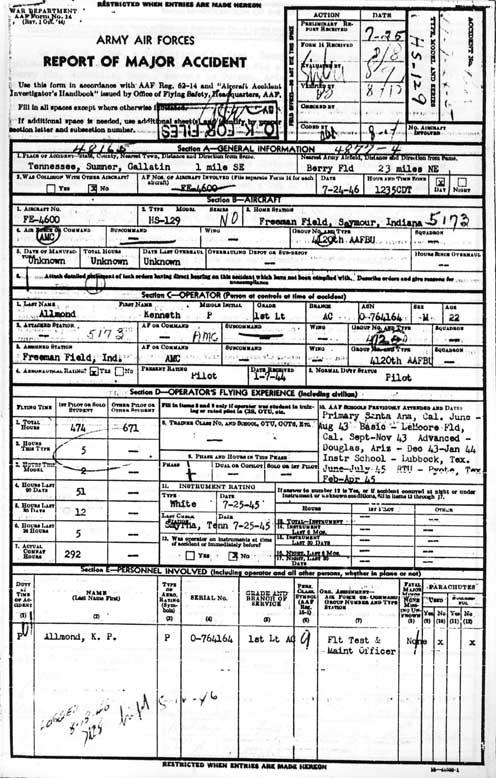
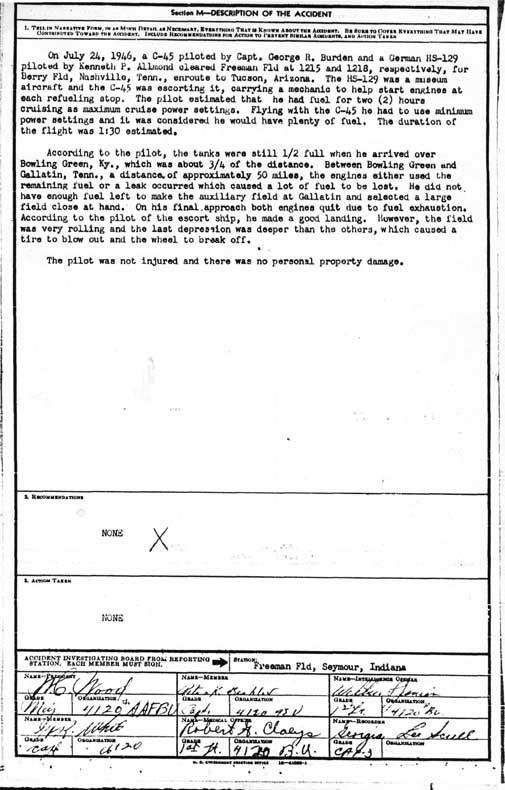
(Source: Indiana Military Organization)
AAF Form No. 14 - Report of Major Aircraft Accident
(Source: Indiana Military Organization)
Re: Army Air Forces and Other World War II Forms
Thu Jun 18, 2020 8:35 pm
AAF Form No. 21A - Log Sheet - Navigator [Alternate Version]
[PDF File]
(Source: Kathyamen.net)
I also found a copy of AAF Regulation No. 15-23, which describes how to use AAF Form No. 23 and 23A.


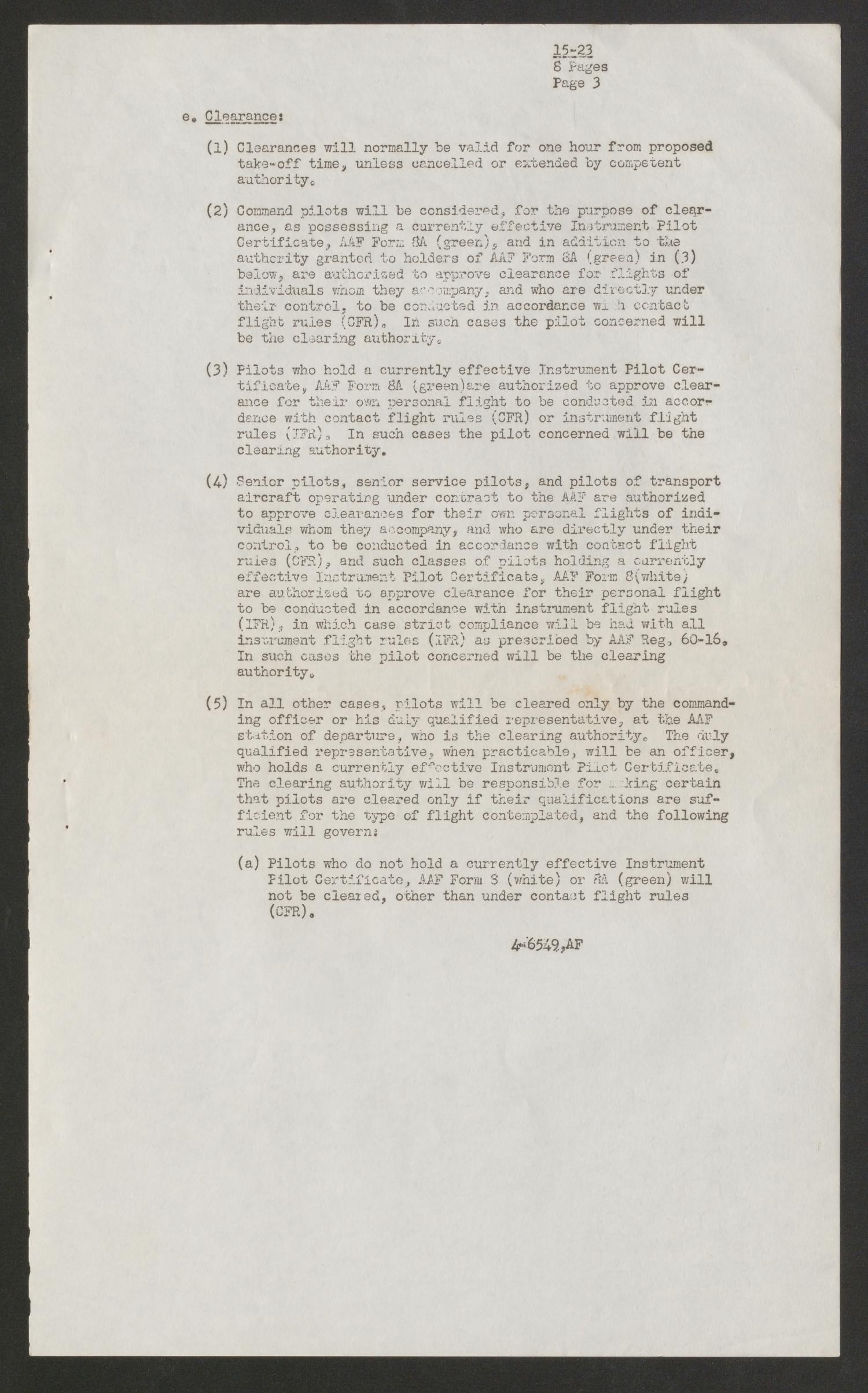





(Source: The Portal to Texas History)
Copies of the Airman's Guide, Military Review, and Air Surgeon's Bulletin provide details on the utilization of AAF Form No. 23; 81, 82 & 121; and 121, respectively.
On the subject of associated hardware, there was apparently a "Sorting and Filing Cabinet" for AAF Form No. 137 - Duty Assignment Card:



(Source: War Relics Forum)
To follow up on the previous post about U.S. Navy forms, I came across a manual from 1955 that listed a few more:
List of NavAer Forms (Cont.)
Reference: Aviation Machinist's Mates' Manual (9-4)
[PDF File]
(Source: Kathyamen.net)
I also found a copy of AAF Regulation No. 15-23, which describes how to use AAF Form No. 23 and 23A.
(Source: The Portal to Texas History)
Copies of the Airman's Guide, Military Review, and Air Surgeon's Bulletin provide details on the utilization of AAF Form No. 23; 81, 82 & 121; and 121, respectively.
On the subject of associated hardware, there was apparently a "Sorting and Filing Cabinet" for AAF Form No. 137 - Duty Assignment Card:



(Source: War Relics Forum)
To follow up on the previous post about U.S. Navy forms, I came across a manual from 1955 that listed a few more:
List of NavAer Forms (Cont.)
- NavAer 140 - Publications and Forms Order Blank - Pad
- NavAer 333B - Monthly Aircraft Engine Report - Pad
- NavAer 416 - Propeller Log Book
- NavAer 418 - Aircraft Log Book
- NavAer 419 - Engine Log Book
- NavAer 452 - Photographic Mounting Card - Pkg.
- NavAer 1086 - Photographic Mounting Data Sheet - Pad
- NavAer 1097 - Engine Warning Sticker - Pkg.
- NavAer 1993 - Inventory of Small Boats - Sheet
- NavAer 2061 - Oxygen Check List - Duration Chart - Card
- NavAer 2300 - Authorized Standard Loadings - Pad
- NavAer 2325 - Aircraft Crash Fire Report - Pad
- NavAer 2491 - Overhaul Activity Disassembly and Inspection Report - Card
- NavAer 2650 - Aircraft Equipment Condition Tag - Pkg.
- NavAer 2650A - Aircraft Equipment Condition Label - Pkg.
- NavAer 2700 - Naval Aircraft Flight Record - Pad
- NavAer 2826 - Empty Metal Engine Container Report - Pad
- NavAer 3121 - Daily Non-Rigid Flight Inspection - Pad
- NavAer 3142 - Arresting Gear Crash and Damage Report - Sheet
- NavAer 3143 - Quarterly Flight Deck Operation Report, Aircraft Carriers
- NavAer 4111 - Aviators Flight Log Book
- NavAer 4112 - Report of Unsatisfactory or Defective Material - Pad
- NavAer 4120E - Instrument Rating (Aircraft) - Card
Reference: Aviation Machinist's Mates' Manual (9-4)
Re: Army Air Forces and Other World War II Forms
Tue Jul 14, 2020 10:26 pm
AAF Form No. 121 - Individual A.A.F. Issue Record [Alternate Version]

(Source: B26.com)
AAF Form No. 121 - Individual Issue Record [Alternate Version]
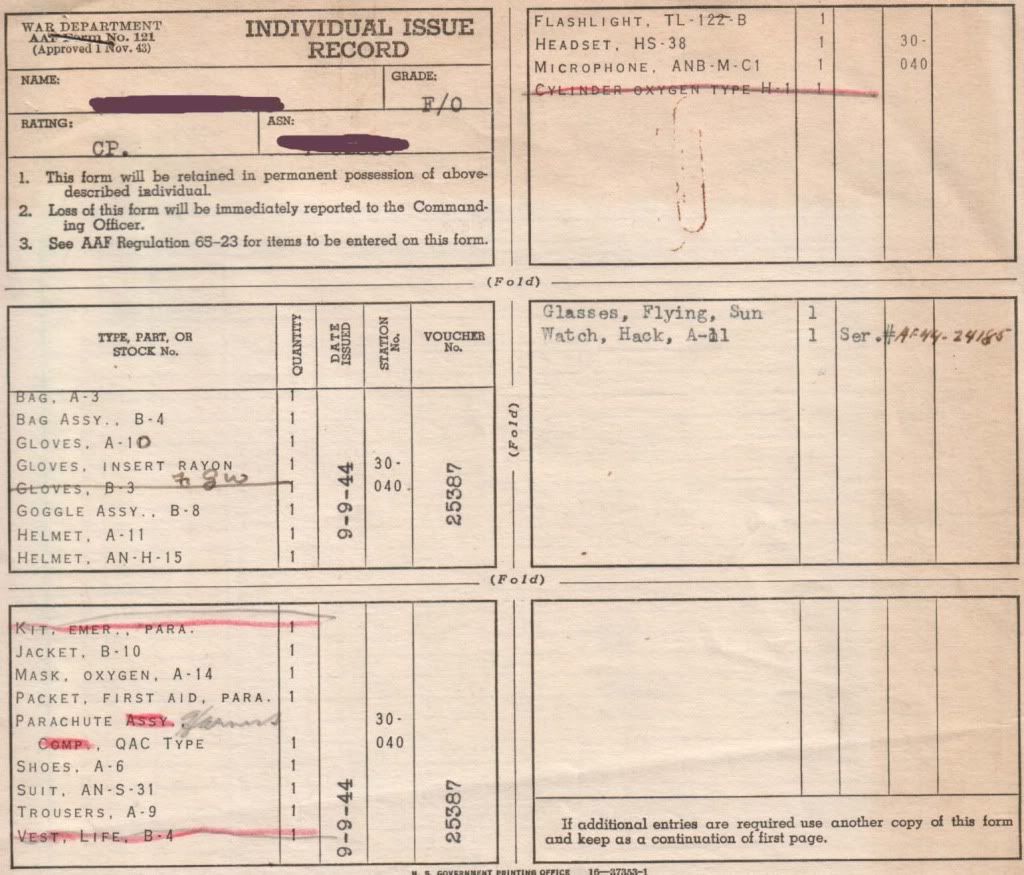
(Source: Fedora Lounge)
Here's a form with a number, but it's not clear whether it is an AAF form:
Form 17-2 - Check List A/O Shipping Ticket
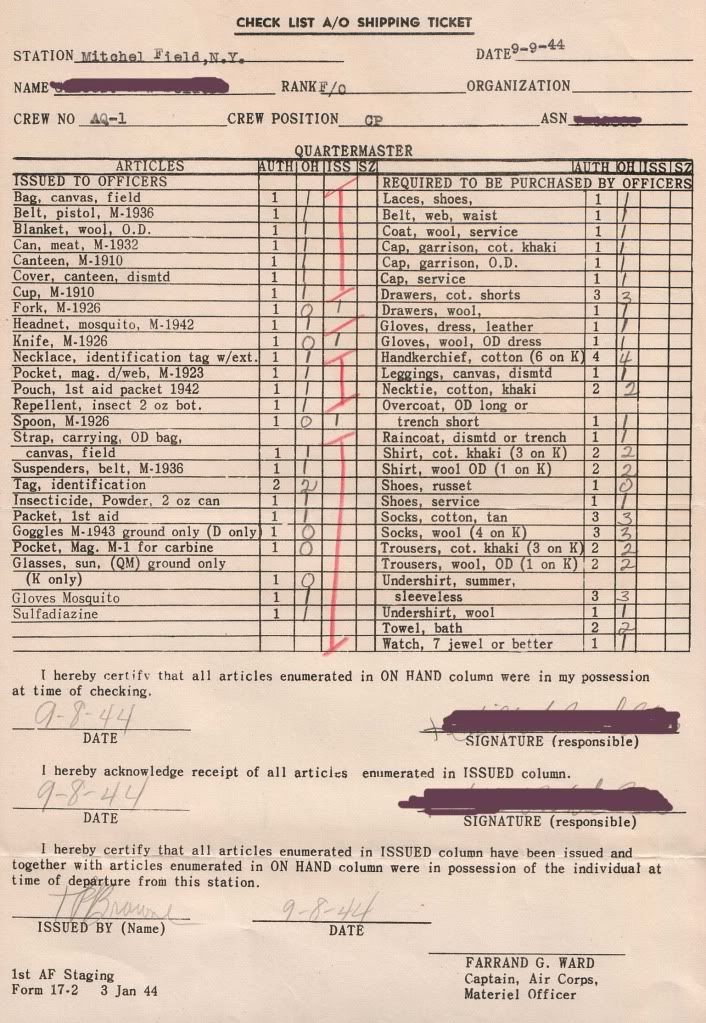
(Source: Fedora Lounge)
Apparently the Ferrying Division had their own set of forms. For the first set of forms below, while it's not clear if all pages are technically part of 50-34A:
Fer. Div. Form. No. 50-34A - Pilot's Training Record









(Source: Internet Archive)
Fer. Div. Form. No. 55-4 - Pilot Qualification Record
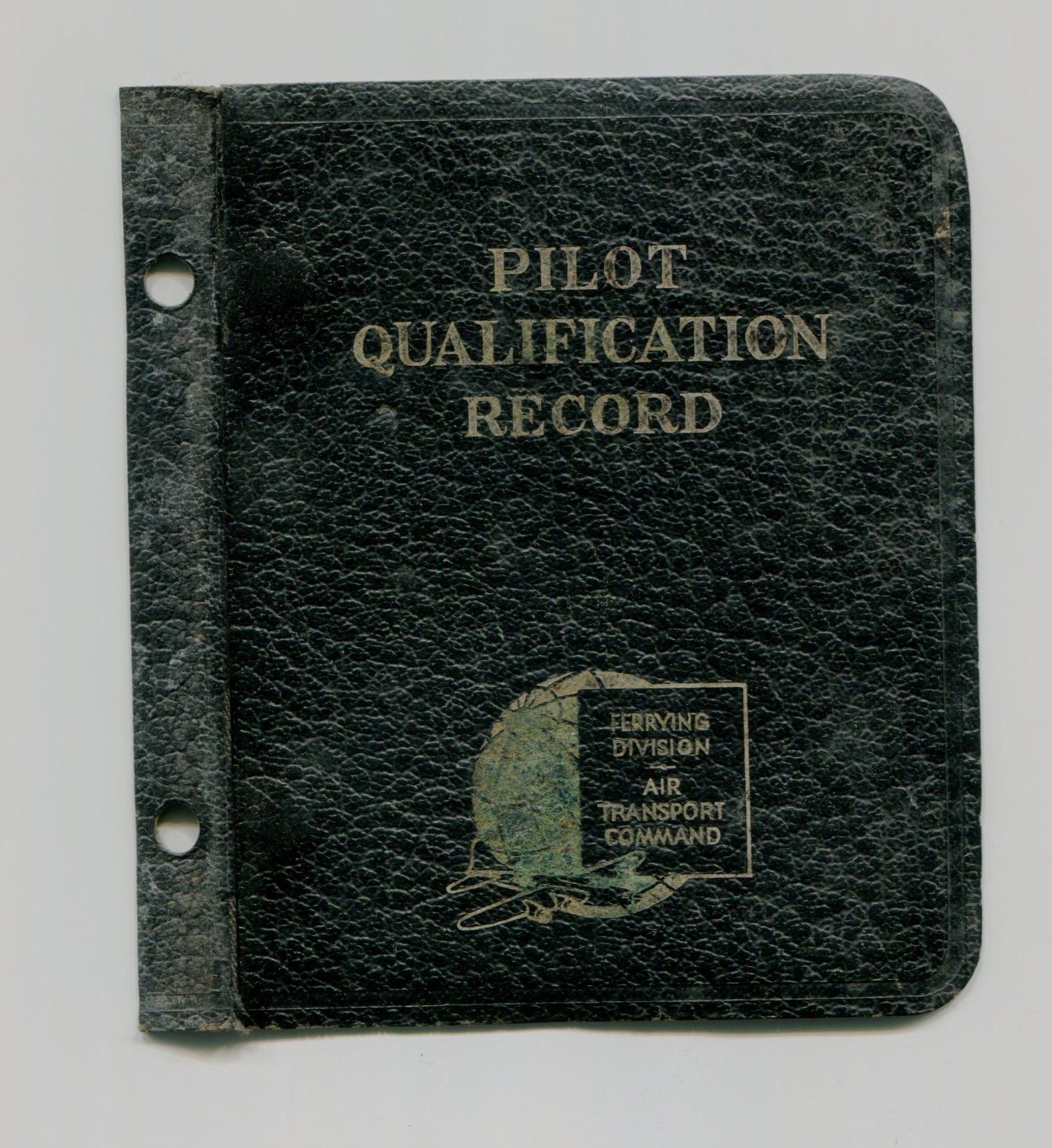
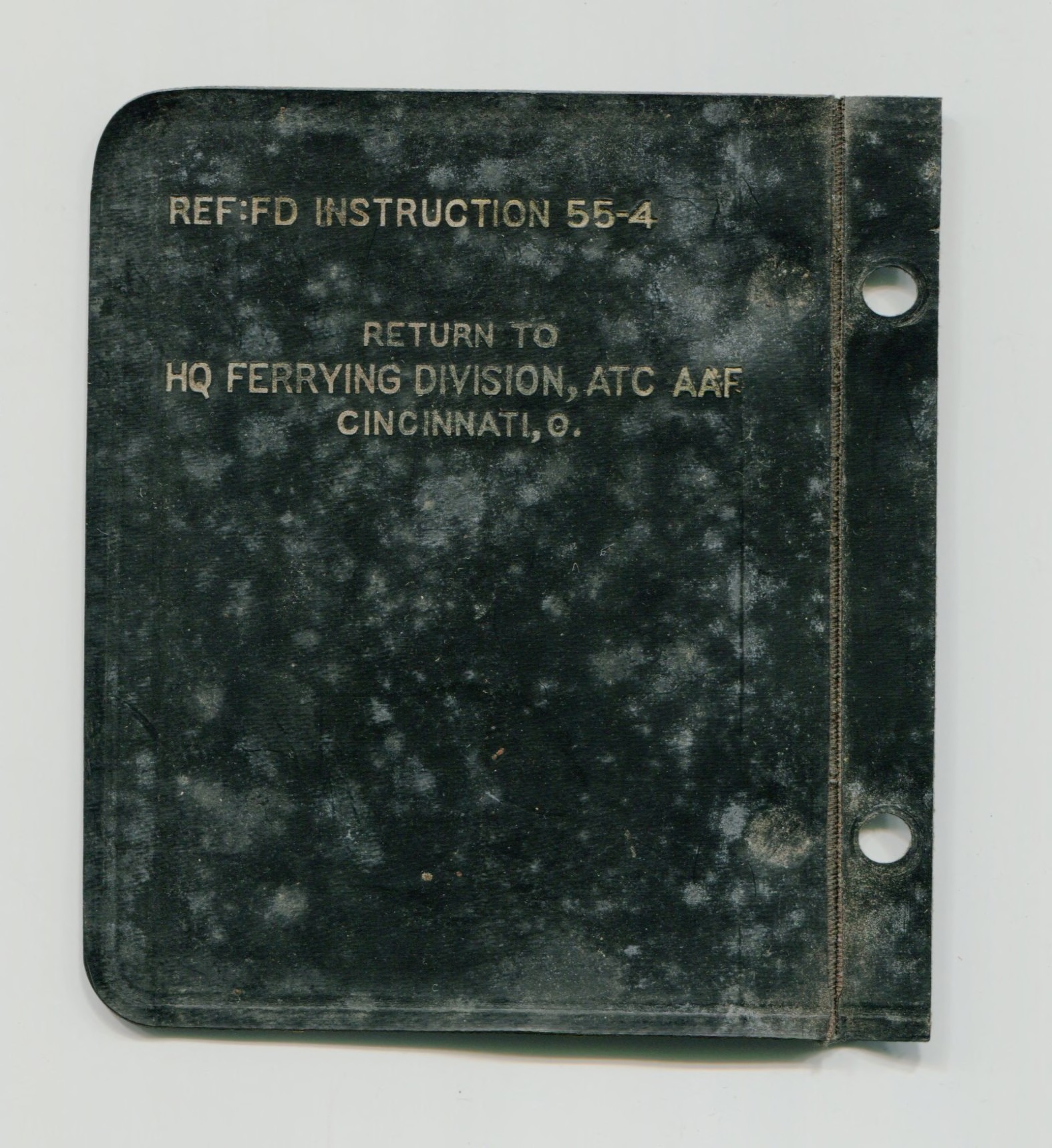
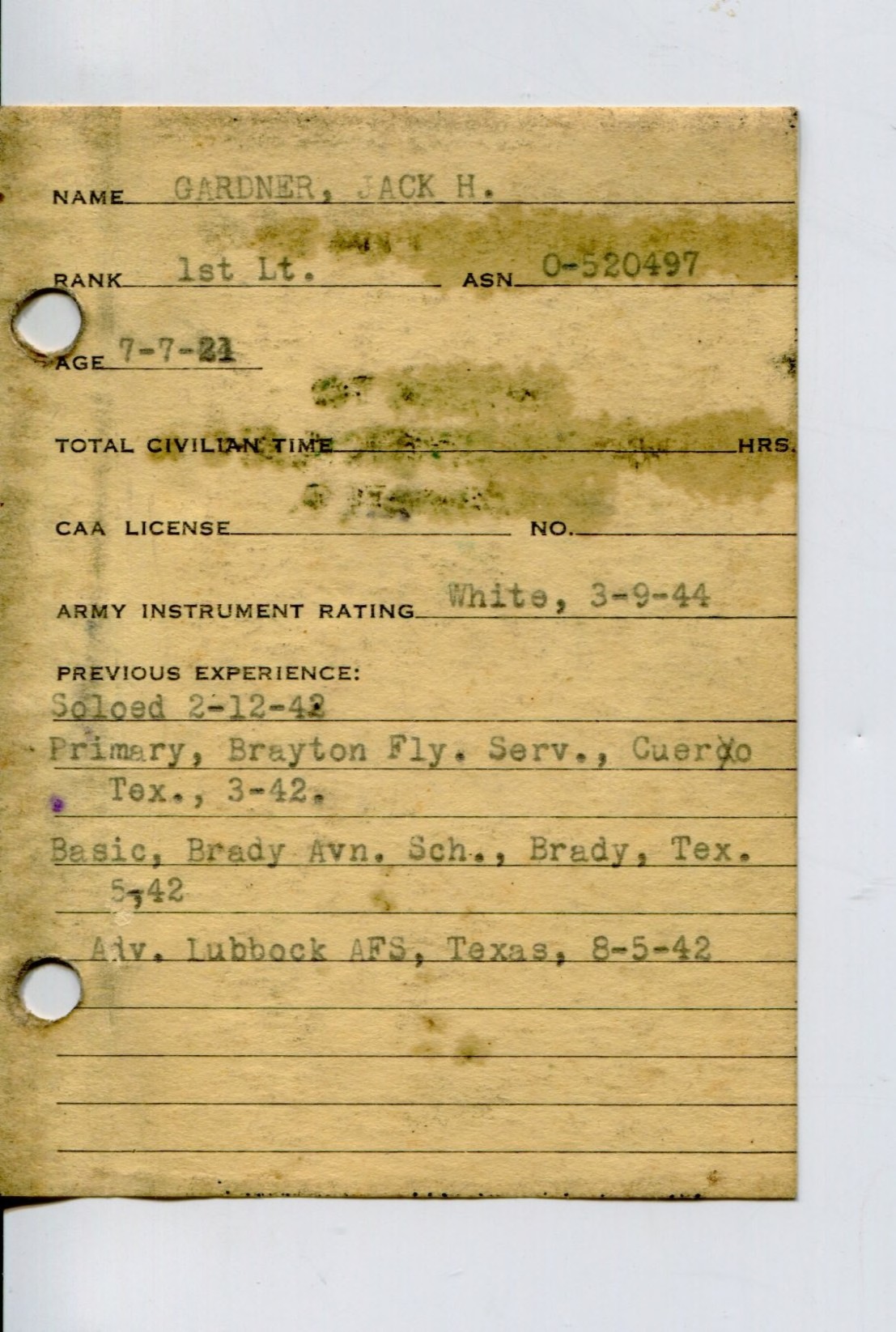
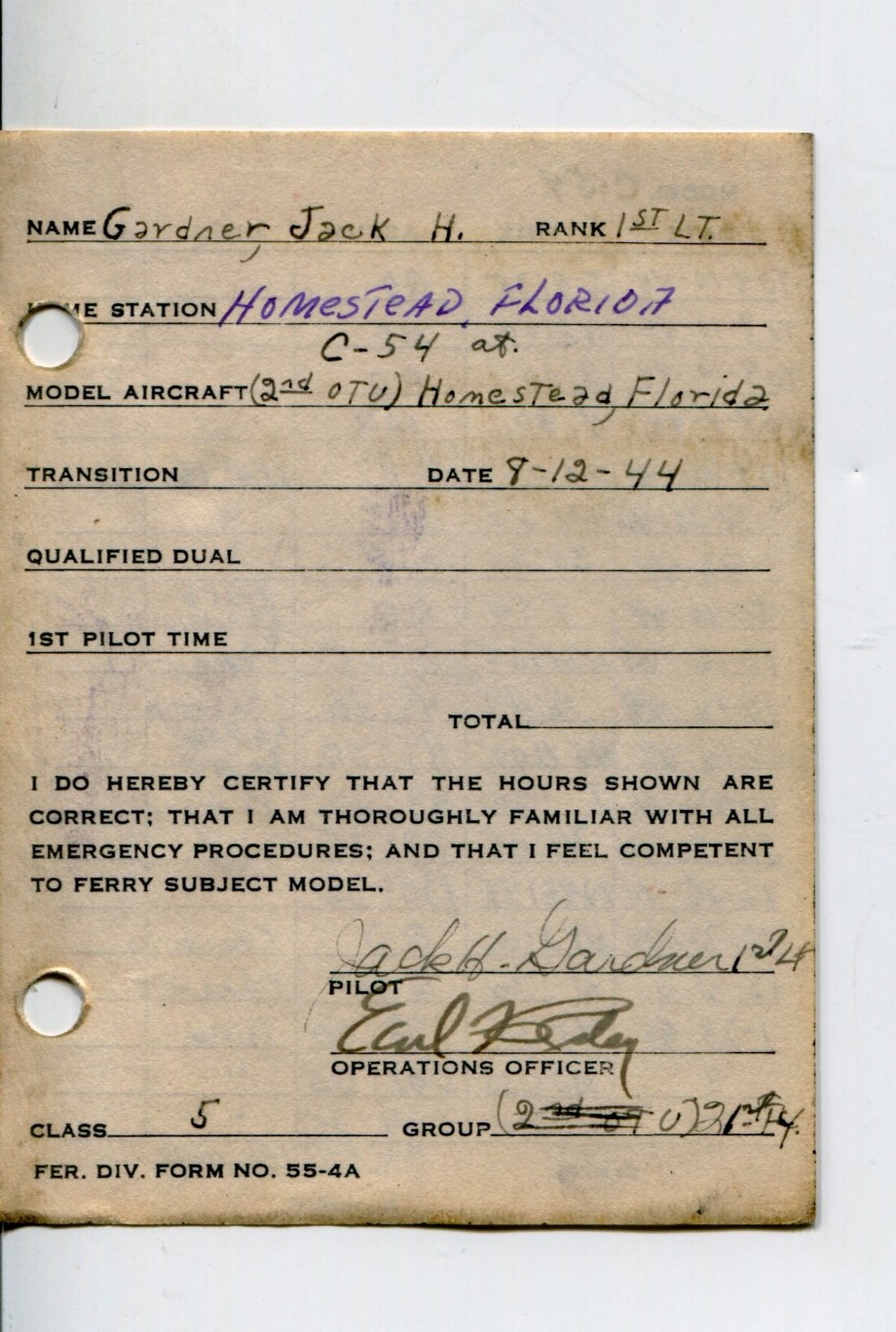
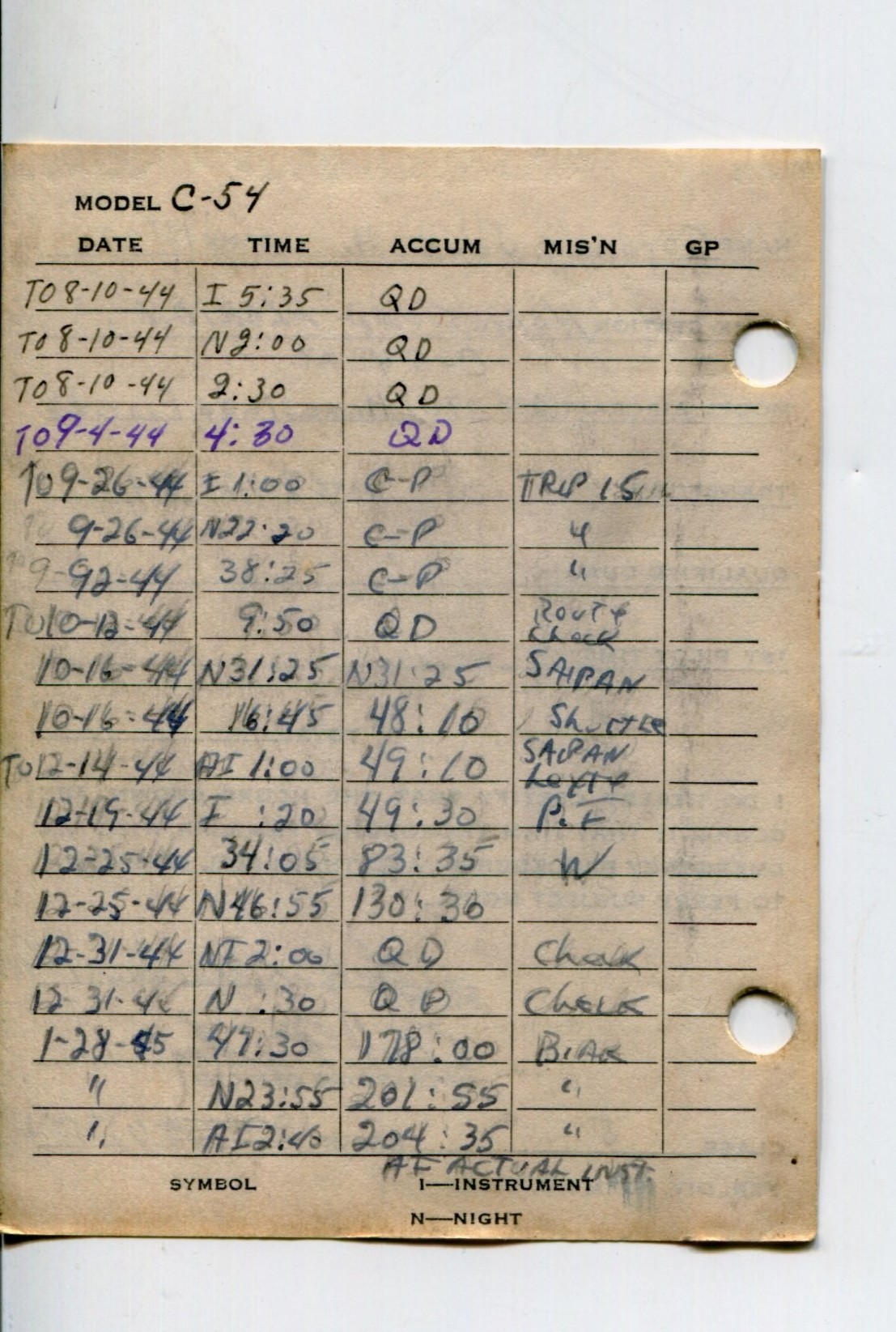
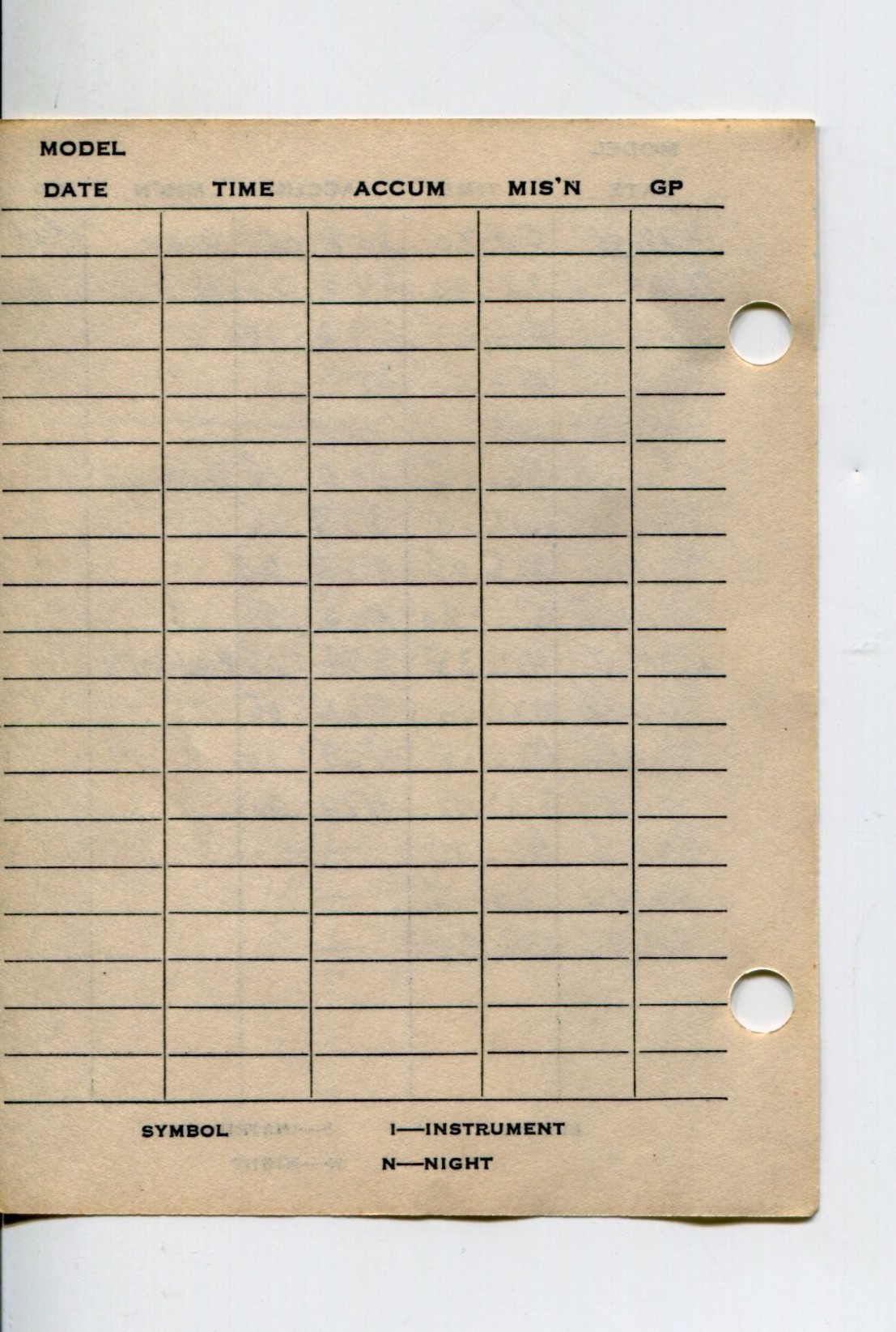
(Source: Internet Archive)
Fer.Div. Form 65-6B
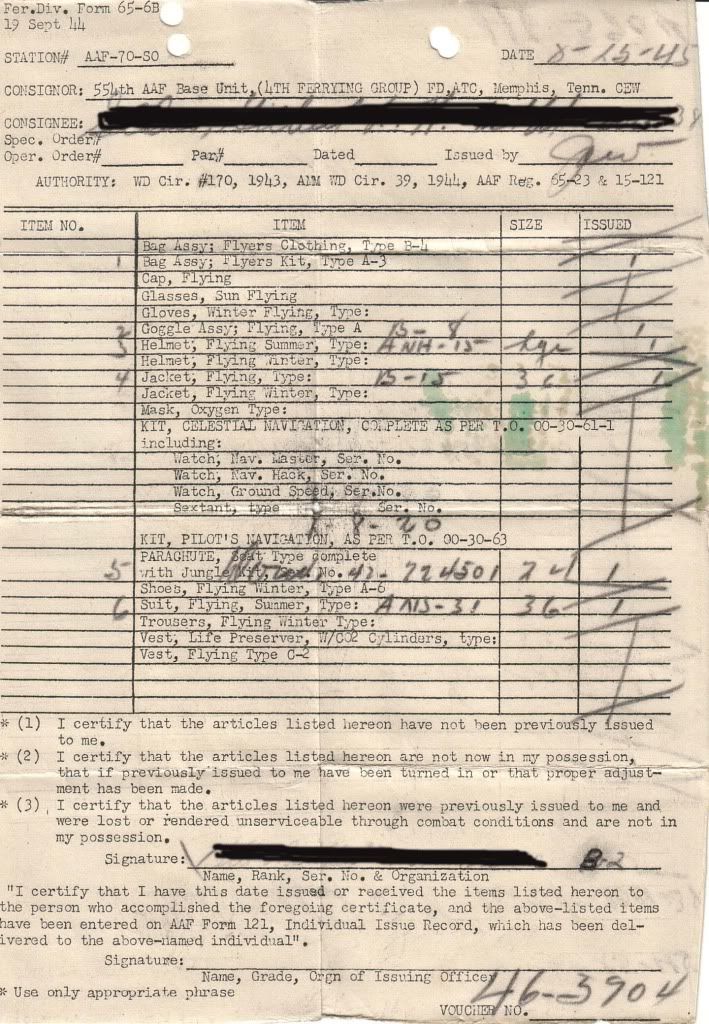
(Source: Fedora Lounge)
Fer Div Form No. 75-10E - Aircraft Delivery Memorandum

(Source: Hathi Trust)

(Source: B26.com)
AAF Form No. 121 - Individual Issue Record [Alternate Version]

(Source: Fedora Lounge)
Here's a form with a number, but it's not clear whether it is an AAF form:
Form 17-2 - Check List A/O Shipping Ticket

(Source: Fedora Lounge)
Apparently the Ferrying Division had their own set of forms. For the first set of forms below, while it's not clear if all pages are technically part of 50-34A:
Fer. Div. Form. No. 50-34A - Pilot's Training Record
(Source: Internet Archive)
Fer. Div. Form. No. 55-4 - Pilot Qualification Record
(Source: Internet Archive)
Fer.Div. Form 65-6B

(Source: Fedora Lounge)
Fer Div Form No. 75-10E - Aircraft Delivery Memorandum
(Source: Hathi Trust)
Re: Army Air Forces and Other World War II Forms
Fri Jul 17, 2020 4:42 am
Hey Noah: The record bag you showed in your 2 June post hasn’t really changed in all the years it’s been used. Current versions have a little big different wording on them and an addition of two thru grommets, just in from the straps. All our ground support equipment has them for current inspection and testing reports.
Re: Army Air Forces and Other World War II Forms
Fri Jul 17, 2020 8:51 pm
Cvairwerks wrote:Hey Noah: The record bag you showed in your 2 June post hasn’t really changed in all the years it’s been used. Current versions have a little big different wording on them and an addition of two thru grommets, just in from the straps. All our ground support equipment has them for current inspection and testing reports.
I guess the more things change...
Anyway, thanks for the info. Interesting stuff. Are the forms still numbered 60B, or have they changed?
Actually, on a related note, I was doing some research about some of the classic cars on display at our museum and that involved looking through old owners manuals. In the process I came across a sample of a "Dealer New Car Delivery Report" and darn if it doesn't look just like the USAAF forms. Unfortunately, it's a bit too small to read the text, but the font, the stamp in the upper left, the appearance of the dashed lines for the empty fields, the double lines used as section separators - they're all essentially the same!
Between this and the sample kardex from the aircraft history card request thread, it really makes me realize how widespread usage of this filing and record keeping system must have been. Even the Royal Australian Air Force cards look the same.
Re: Army Air Forces and Other World War II Forms
Sat Jul 18, 2020 2:22 pm
Noha: No idea on the engine forms. I rarely every see an engine that is not installed on an a/c. They come into the plant all cocooned and make several stops before they end up in our engine shop. There, the guys and gals inspect them, decocoon them and build them up. After that, they move them to the factory and do the install there. I deal with the a/c once it's ready for first engine run thru the actual delivery launch to the receiving unit or country.
Re: Army Air Forces and Other World War II Forms
Mon Jul 20, 2020 12:19 pm
Over the years I have collected many AAF forms, certificates, SOPs and other paperwork. Some filled, some blank. If someone is looking for a form or other let me know. I can send a copy.
Ken
Ken
Re: Army Air Forces and Other World War II Forms
Mon Jul 20, 2020 5:44 pm
Lightninglover wrote:Over the years I have collected many AAF forms, certificates, SOPs and other paperwork. Some filled, some blank. If someone is looking for a form or other let me know. I can send a copy.
Ken
While I would love to see everything posted here, I don't want to foist that level of work upon you. Instead, could you fill in any of the blanks on the list below? No need to post a scan, just the number and title combination. Just having that makes them a lot easier to find:
List of AAF Forms
- 1 - Airplane Flight Report - Operation
- 1A - Airplane Flight Report - Engineering
- 5 - Individual Flight Record
- 5S - Individual Flight Record
- 7 - Flying Evaluation Report
- 8 - Instrument Pilot Certificate (White)
- 8A - Instrument Pilot Certificate (Green)
- 8B - Pilot Instrument Certificate Applicate and Flight Check Form
- 9 - Flight Envelope
- 12C - Bombing Flight Record
- 14 - Report of Major Accidents
- 14A - Report of Minor Accidents
- 15 - Invoice
- 15A - Invoice Envelope
- 17 - Damage to Property Certificate
- 18 - Daily Control Tower Operations Log
- 18A - Monthly Runway Traffic Report of Airplane Landings and Take-Offs
- 21A - Navigator's Log (Small Form)
- 21B - Air Navigation
- 21C - Air Navigation
- 21D - Line of Position, Ageton Solution
- 21E - Airspeed Calibration Card
- 21F - Air Navigation
- 21G - Air Navigation
- 21H - Air Navigation
- 21I - Air Navigation
- 21J - Air Navigation
- 21K - Line of Position
- 21M - Altimeter Scale Correction Card
- 21Q - Great Circle Computation, Ageton Solution (Course and Distance)
- 21R - Great Circle Computation, Ageton Solution (Lat Lo of Intermediate Point - x-1, x-2, etc.)
- 21U - Factors for Ground Speed by Timing
- 23 - Aircraft Clearance
- 23A - Vertical Cross Section Forecast
- 24 - PIF Table of Contents
- 24A - Temporary Compliance Certificate for PIF
- 24N - NIF Table of Contents
- 24NA - Temporary Compliance Certificate for NIF
- 24B - BIF Table of Contents
- 24BA - Temporary Compliance Certificate for BIF
- 24R - ROIF Table of Contents
- 24RA - Temporary Compliance Certificate for ROIF
- 28 - Army Air Forces Physical Fitness Test Report
- 28A - Army Air Forces Physical Fitness Test and Record Card
- 28B - Army Air Forces Physical Fitness Test and Record Card
- 34 - Weekly Status and Operations Report
- 35 - Radio Log
- 36 - Weather Station Operations Report
- 38A - Inventory of Equipment
- 39 - Aircraft Accident Log
- 41B - Maintenance Inspection Record (Book Form)
- 42 - Inspection and Preventative Maintenance Record for Aircraft Crash Rescue and Aircraft Crash Fire Fighting Equipment
- 46 - Parachute Log Record
- 48 - Work Order
- 49 - Serviceable Part Tag (Yellow)
- 49A - Serviceable Part Tag (Yellow Label)
- 50 - Repairable Part Tag (Green)
- 51 - Condemned Part Tag (Red)
- 54 - Unsatisfactory Report
- 55 - Daily and Weekly Inspection and Servicing Work Sheet for AAF Motorized Equipment
- 56 - Maintenance Inspection Record
- 57 - Pilot's Compass Correction Card
- 58 - Parachute Inspection and Drop-Test Card
- 60A - Technical Instruction Compliance Record (Aircraft)
- 60B - Technical Instruction Compliance Record (Engines)
- 61 - Propeller Historical Record
- 63 - Foreign Airport Description
- 66 - Preventative Maintenance Service and Technical Inspection Modified Work Sheet for AAF Vehicle Special Equipment and Items of Motorized Equipment
- 81 - Stores Charge
- 82 - Stores Credit (Yellow)
- 83 - Identification Tag (White)
- 83A - Identification Tag UR (White)
- 90 - Aircraft Instrument
- 96A - Cargo and Passenger Manifest
- 96B - Cargo and Passenger Manifest
- 97A - Purchase Request and Commitment Form (Obligation Record)
- 99 - Memorandum Request
- 102 - Requisition
- 104A - Shipping Ticket
- 104B - Supplementary Requisition and Shipping Ticket (Domestic)
- 104C - Supplementary Requisition and Shipping Ticket (Domestic)
- 105F-1 - Stock Control Record
- 105F-2 - Stock Record
- 105F-3 - Stock Activity Record
- 105F-4 - Due in and Due Out Record
- 105F-5 - Stock Control and Activity Record
- 108W - Weather Station Equipment Report
- 110A - Daily Aircraft Status and Flying Time Report
- 110B - Monthly Aircraft Status, Flying Time, and Serial Number Inventory Report
- 121 - Individual AAF Issue Record
- 122 - Report of Disabling Injury (Military and Civilian)
- 123 - Officer's Evaluation Report
- 127 - Personnel Report
- 128 - AAF Personal Affairs Statement
- 132 - Installation Housing Report
- 134 - Report of USAF Civilian Personnel
- 137 - Duty Assignment Card
- 203 - Care of Flyer Report
- 205 - Medical Officer's Report of Aircraft Accident
- 206 - Air Crew Member Physical Record Card
- 242 - Foreman's Progress Report
- 243 - Bill of Material
- 244 - Aircraft Delivery Receipt and Paper Work List
- 249 - Stores Exchange
- 250 - Time Card
- 262 - Inspector's and Pilot's Final Acceptance Report
- 263 - Aircraft Checkers Report
- 263-B - Aircraft Checkers Report[,] Winterization Checklist
- F - Balance and Weight Control - Aircraft
List of AC Forms
- 1 - Forced Landing Report
- 3 - Monthly Aircraft Operations Report
- 4 - Training and Operations
- 11 - Transcript of Flying Record
- 14 - Aircraft Accident Report
- 15 - Fuel and Lubricants for Government-Owned Aircraft
- 24 - Flight Performance Record
- 41 - Airplane Maintenance Inspection Record
- 41-B - Airplane Maintenance Inspection Record
- 43 - Armament Inspection Record
- 84 - Bin Card
- 95 - Monthly Aircraft Report
- 136 - Training and Operations Reports
- 160 - Unsatisfactory Performance Report
- 192 - Consolidated Aircraft and Engine Report
- 193 - Consolidated Operations and Status of Equipment Report
- 201 - Station Parachute Record
- 227 - Pilot Book
- 245 - Summary of Direct Labor Charges to Accounts
List of AFTRC Forms
- 2 - Officers Proficiency Card
- 4 - Basic Training Card
- 9 - Diploma
- 10 - Certificate of Proficiency
- 24 - Medical Statement
List of Fer. Div. Forms
- 50-34A - Pilot's Training Record
- 55-4 - Pilot Qualification Record
- 65-6B
- 75-10E - Aircraft Delivery Memorandum
List of ACA (CPT) Forms
- 520 (12) - Declaration by Trainee
- 526 (41) - Daily Flight Inspection Record
- 529 (41) - Aircraft Maintenance Record
- 551 (41) - Student Pilot Rating Book (Private Course)
- 594 (41) - CPT Pilot Rating Book
- 724 (40) - Contract for Pilot Training[,] Elementary Course, College Phase
- 732 (40) - Contract for Pilot Training[,] Secondary Course, College Phase
- 733 (40)
List of NavAer Forms
- 333A - Aircraft Engines Report
- 337 - Aircraft Recommended for Striking
- 338 - Weekly Aircraft Receipt and Transfer Report
- 339 - Aircraft Trouble Report
- 421 - Quarterly Pilot Flying Report
- 422 - Property Damage Report
- 432 - Monthly Aircraft Flying Report
- 443A - Monthly Aerological Report (Standard Observations)
- 443B - Monthly Aerological Report (Hourly Observations and Journal)
- 443C - Monthly Aerological Report (Upper Air)
- 443D - Monthly Aerological Report (Surface Winds and General Summary)
- 446A - Aerological Inventory (Supplies)
- 446B - Aerological Inventory (Instruments)
- 4112 - Report of Unsatisfactory or Defective Material
- 4113 - Report of Ferrying Flight (Made by Ferry Pilot)
Re: Army Air Forces and Other World War II Forms
Tue Jul 21, 2020 1:40 pm
Hi again. here are some additional forms I have come across:
12C- Bombing Flight Record
2?- Aircraft Arrival Report
24B- BIF Table of Contents
24BA- Temporary Compliance Certificate for BIF
24N- NIF Table of Contents
24NA- Temporary Compliance Certificate for NIF
24R- ROIF Table of Contents
24RA- Temporary Compliance Certificate for ROIF
35- Radio Log
63- Foreign Airport Description
12C- Bombing Flight Record
2?- Aircraft Arrival Report
24B- BIF Table of Contents
24BA- Temporary Compliance Certificate for BIF
24N- NIF Table of Contents
24NA- Temporary Compliance Certificate for NIF
24R- ROIF Table of Contents
24RA- Temporary Compliance Certificate for ROIF
35- Radio Log
63- Foreign Airport Description
Re: Army Air Forces and Other World War II Forms
Wed Jul 22, 2020 9:33 pm
Lightninglover wrote:Hi again. here are some additional forms I have come across:
Thanks! While I'm pretty sure that I've come across most of those already, I didn't recognize the title of this one:
Lightninglover wrote:2?- Aircraft Arrival Report
so I decided to do a quick Google search for it and came across this result:
AAF Form No. 23 - Aircraft Arrival Report
(Source: The Portal to Texas History)
What's strange is that I had already found a Form 23, but it had a different title. Both have the same revision date, so it's not that one is a later version or replacement of the other. Both even appear to share the same Government Printing Office number! One difference is that while both include the same sections A through E, the Aircraft Arrival Report replaces section F with section G.
To make things even more confusing, both forms include a check box that mentions "AAF Form 23A", so it's clear that neither are Form 23A. However, because a suffix letter is mentioned, it leads me to believe that maybe these two forms have one, but it was just not included. Alternatively, maybe both forms were printed on the same pad carbon copy style, but alternated every other page.
Anyway, if it wasn't for your response, I'm not sure I ever would have realized there were two, so thank you.